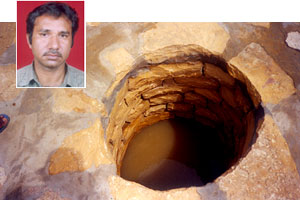India’s water warriors Rajasthan’s rich khazana of traditional water harvesting systems has been barely explored. There is a lot more to discover and revive. Jethu Singh Bhatti, general secretary of the Thar Integrated Social Development Society (TISDS), has brought to life the paar system in Manpia village in Jaisalmer district, with financial support from CSE.
"It is a pity that experts only talk about kundis and talabs," laments Bhatti, "While these are of great significance, we find instances of systems that were intrinsically linked with the hydrology, topography and economy of the region, and have the potential to be more effective." Paar was used as a source of drinking water and fodder in the rocky ridges around Jaisalmer. The system adapts to the sloping terrains in this region and has three key components—the agor or catchment spread over the upper incline or the upstream drainage area; the agar or the downstream region where rainwater flowing in from the agor is stemmed by small earthen embankments; and kuis which are constructed along the agar to extract drinking water for people and cattle. Common or grazing lands, or tracts considered unsuitable for crops were used to build paars. Bhatti has acquired a tract of barren land from the revenue department, via the panchayat —by getting a no objection certificate from the authorities. Bhatti uses the agar, where the soil has a high moisture content, to grow fodder. A part of this tract is also being used to grow rare and endangered desert plant species. This, he says, will ensure returns from the land and take care of the maintenance costs of the paar. With Bhatti at the helm of affairs, the paar in Manpia has emerged as an ideal case study of a traditional technique, revived with innovative modifications, that sustains the region’s age-old pastoral economy. A number neighbouring villages are now working under Bhatti’s expert guidance to make themselves "paar-equipped". Jethu Singh Bhatti Sharing irrigation water — especially in the water-stressed regions of India — is a highly explosive issue, often turning a farmland into a battleground. But the Paani Vitaran Samiti (PVS), created by the people of Gandhigram in the semi-arid zone of Gujarat’s Kachchh district, has found a solution: A water-tight distribution schedule. The impact is already evident. While Kachchh was reeling under a severe drought in 2002-2003, Gandhigram produced groundnut worth Rs 2,000,000.
The PVS draws up a chart every year for both Kharif and Rabi seasons, based on the volume of rainfall received. It announces the type of crops that will be grown by the farmers, and the area that will be allotted to each of these. The calculation is made on the basis of how much water will be required and whether the village can afford to supply the amount. The samiti, on behalf of the community, ensures that highly water-intensive crops are avoided in the dry years. Every farmer abides by the guidelines set. Because the distribution process is extremely equitable, the allocations are made on a first-come first-served basis. The samiti, however, is strict about the payment made in lieu of the water received. If a farmer defaults once, he is blacklisted and is refused his share. Till he pays up. Again, there is no resentment because the money sustains the community kitty, which takes care of the maintenance and development of the water infrastructure. "During the monsoon season in 2002, we noticed a leak developing in the Lokshakti dam, which was built by the villagers. All of us joined hands with the PVS to plug it", says Narayan Bhai Karshanbhai Choudhary, a farmer.
|
|||||||||||||||||||||||||||
| |
|||||||||||||||||||||||||||

